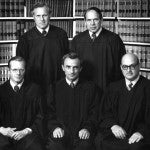
Judge Robes: A Look at the Product Part II
Share

In part two of this in-depth look at judge robes article, we take a look at a very simple question that is often overlooked by most: why do judges wear robes that are colored black? Why don’t they utilize other colors more often? Well to those who were curious about it, the answer is finally within your grasp! For those who have yet to read part one, click here.
When the United States of America first achieved independence from England, the Founding Fathers sought to create a government and in doing so, they chose to utilize English common law as a template for the new nation’s laws and proceedings. A little known fact is that in the establishment of the laws, the Founding Fathers also discussed the judicial dresses that were to be worn.
They were conflicted and often argued amongst themselves; Thomas Jefferson, backed by certain peers, wanted judges to wear suits. The reason for this was to get rid of the last vestige of their English roots. Jefferson’s proposal was met with opposition by one John Adams, who went the opposite direction and preferred the keeping of the original tradition alive. Fortunately, the issue was resolved with a compromise; the old English tradition of robe wearing was kept, but the powdered wigs were not. Despite the desire for departure from English tradition, some parts of it were kept.
One of them was the wearing of scarlet robes for Supreme Court Justices. This all changed when Chief Justice John Marshall switched the color from red to black upon being sworn in 1801. The change was directly made and was never verbally proclaimed. Due to Marshall’s trendsetting actions, United States judges have worn black colored robes ever since. Judges may wear black due to that tradition, but it must also be stated that are exist some states where the rules define what Justices wear.
These are exceptions, however, and most states do not have such rules. One good example of this exception is when Byron Johnson, a former Supreme Court Justice of Idaho, wore a royal blue robe over a black one due to the fact that he claimed to sit in a ‘black and blue’ court. Despite that, the wearing of black robes is likely to continue for a long time considering how rooted in tradition the United States is.
